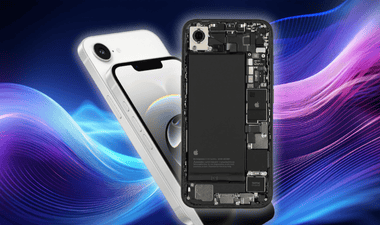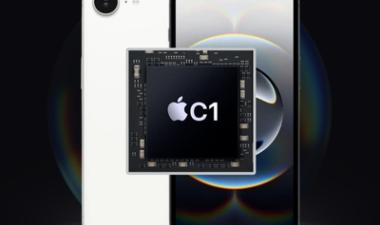Posted: January 20, 2017
Contributing Authors: Jim Morrison and Daniel Yang
The AirPods were announced back in September of 2016 and our analysis team at TechInsights had eagerly anticipated them to be for sale in October. However, October and November came and went and still no AirPods and no real explanation of why they were delayed.

W1 wireless SoC from Apple
Beats headphones sporting the W1 wireless SoC
We had been anxious to see these new wireless hearables because we wanted to see the W1 wireless SoC and the inertial sensors, and so the delay was frustrating. However around mid-November, we were walking through the Frankfurt airport and saw a kiosk featuring Beats Studio wireless headphones. We had a couple of spare minutes and gave them a try. The sound was fantastic. The salesperson was very well educated on the headphones and answered all of our questions. The one surprising question she answered was “What wireless SoC is being used inside these Beats’ headphones?” She responded “ohh, the W1 is inside”. We snapped a quick picture and texted it off to our procurement colleague. Our team got cracking and even before arriving home from Europe we had ourselves our first look at the W1 wireless SoC from Apple.

Latest IoT SoC's Die Size vs Wireless Standard
Comparing the W1 from the AirPods and the Beats
The W1 chip found in the Beats Studio wireless headphone has the package mark 343S00131. Meanwhile, the W1 chip torn down from the Apple AirPods has the package mark 343S00130. They have a slight difference in the last digit in the package marks. TechInsights has confirmed that both 343S00131 and 343S00130 have the same die. This die measures 4.42 mm x 3.23 mm = 14.3 mm2. TechInsights has been tracking Internet of Things (IoT) SoCs for over a year and our observations indicate that this new W1 SoC is very competitively placed when comparing its die size and connectivity specification of Bluetooth 4.2 or greater. As far as the Bluetooth specification is concerned, Apple does not say if it the W1 is BT4.2 or BT5.
What Apple does tell us is that the Beats Solo3 Wireless On-Ear Headphones is Bluetooth Class 1. “Connect via Class 1 Bluetooth with your device for wireless listening” Class 1 Bluetooth has a range of approximately 100 meters and supports higher power, where Class 2 bluetooth is on the order of 10 meters with a lower power specification. Since we know that the Beats Headphones use the exact same W1 die as does the AirPods, then could the AirPods be also considered a Class 1 Bluetooth product? The iPhone 7 does not mention Class 1 Bluetooth, but the spec does state BT4.2 as its standard. So it is not quite clear if the W1 SoC is BT4.2 or BT5. What we do know is the range is very good and the audio quality is also very very good. The W1 may be the best performance IoT SoC on the market today.
The only other chip featuring a smaller die size for Bluetooth 4.2 or greater is the Dialog DA14680 coming in at 10.36 mm2. The roadmap for this device is up and to the right.TechInsights is constantly monitoring the IoT landscape for the emergence of new SoC’s.

Apple W1 Bluetooth SoC at polysilicon measuring 3.23 mm x 4.42 mm
Further analysis
Given the size of this die and its featured operating specifications we will be producing a basic benchmarking report on this W1 processor. The report will identify the process node and foundry; and contain a floor plan analysis and die utilization table, as well as cost estimate for the tested and packaged device.
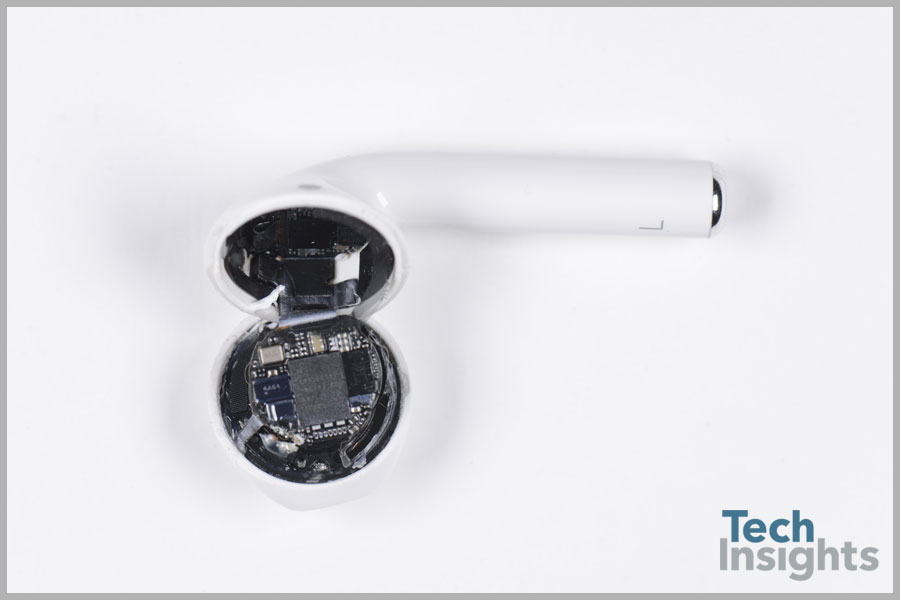
Apple AirPods
Tearing down the AirPods
Now let’s get on to looking at the rest of the AirPods. Our pair arrived just in time for Christmas but we unwrapped and examined in the New Year. Something exciting for our technology analysis team to beat the January blues with!
Our primary interest is in the devices that we can identify from package markings or from industry information. The ear bud contains one single sided PCB and one double sided PCB and a small flex tail that extends towards the lower end of the AirPod.
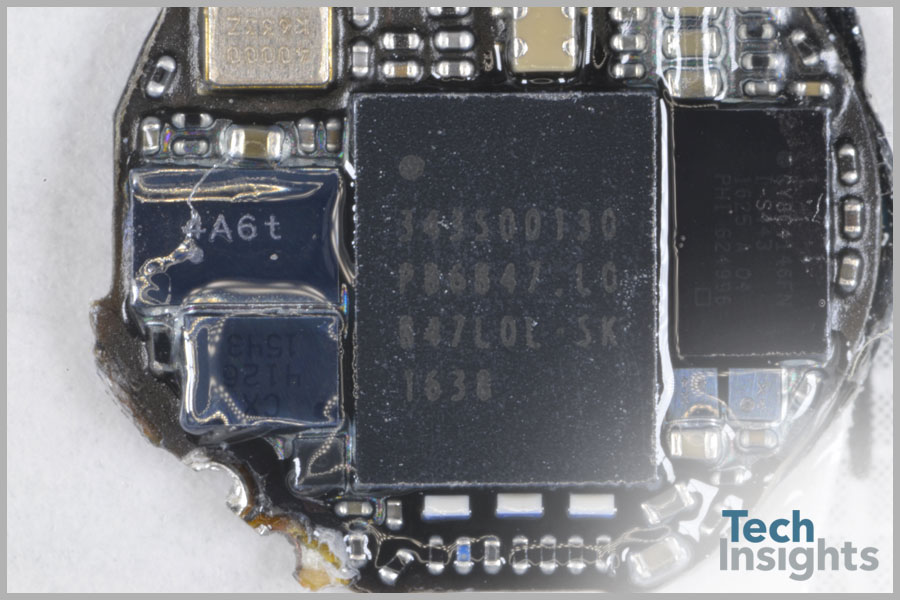
Single sided PCB
Design wins
On the single sided PCB we find the W1 SoC, a Cypress SoC, an STMicroelectronics low drop out regulator and some other components to be identified in detail in our upcoming Deep Dive Teardown report.
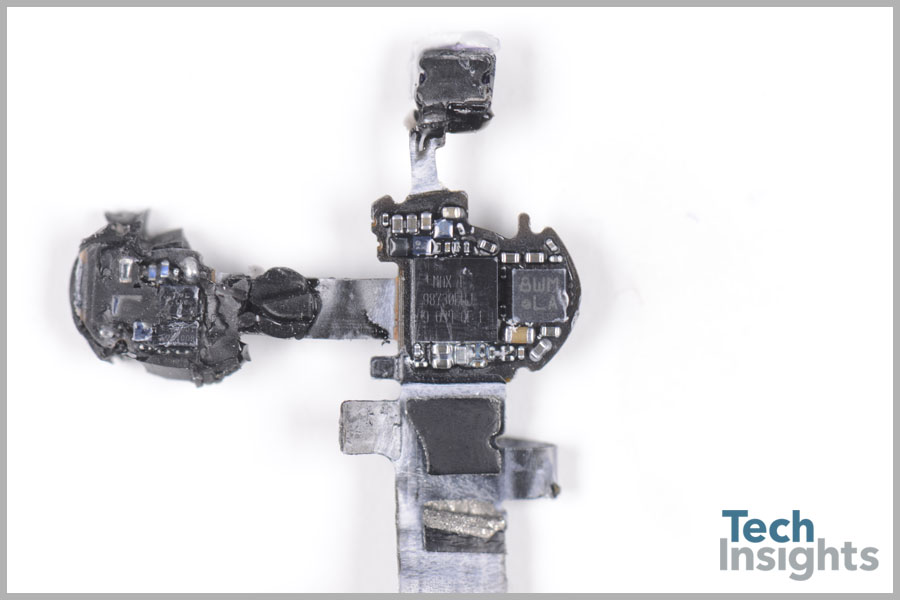
Double sided PCB Front
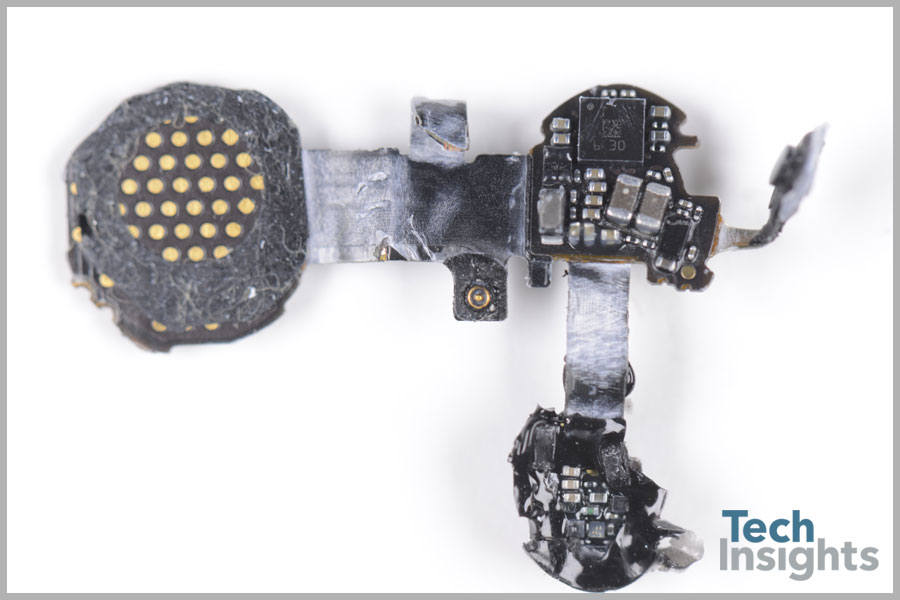
Double sided PCB Back
On the double-sided PCB we find a Maxim audio codec and a Bosch BMA280 accelerometer on one side. On the other side we find an STMicroelectronics ultra low power 3-axis accelerometer, one STMicroelectronics low dropout regulator (LDO), an unidentifiable light sensor and some passives.
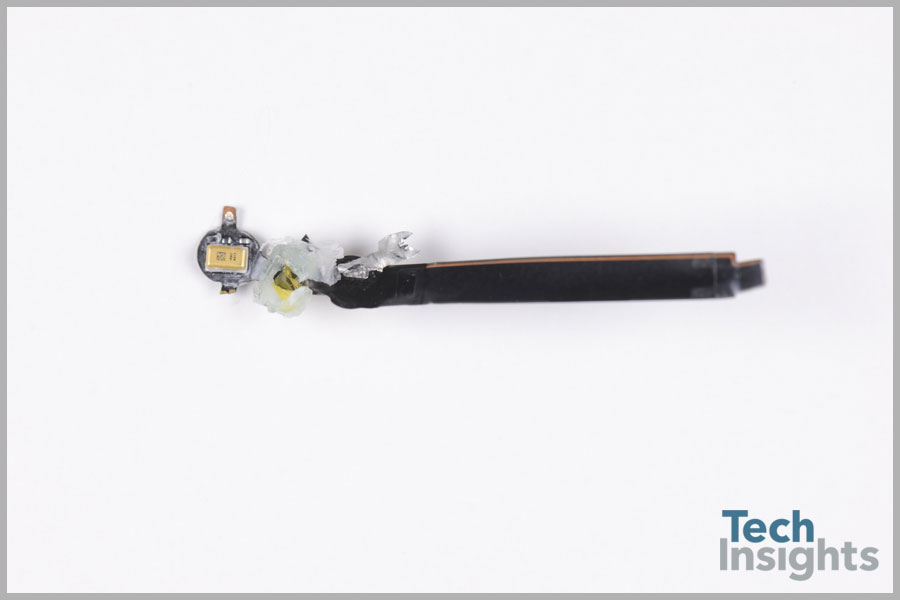
Flex tail and battery assembly
On the flex tail and battery assembly at the end of each AirPod we see a microphone from Goertek.
Each Airpod is identical in design and chip count. Within the two ear buds, here are the major IC counts:
| Design | Chip Count |
|---|---|
| W1 Processor | 2 |
| Cypress SoC | 2 |
| Maxim audio codec | 2 |
| Bosch BMA280 accelerometer | 2 |
| STMicroelectronics ultra low power 3 axis accelerometer | 2 |
| STMicroelectronics low dropout regulator | 2 |
| Texas Instruments data converter | 2 |
| Goertek MEMs microphone | 4 |
| Ear bud battery | 2 |
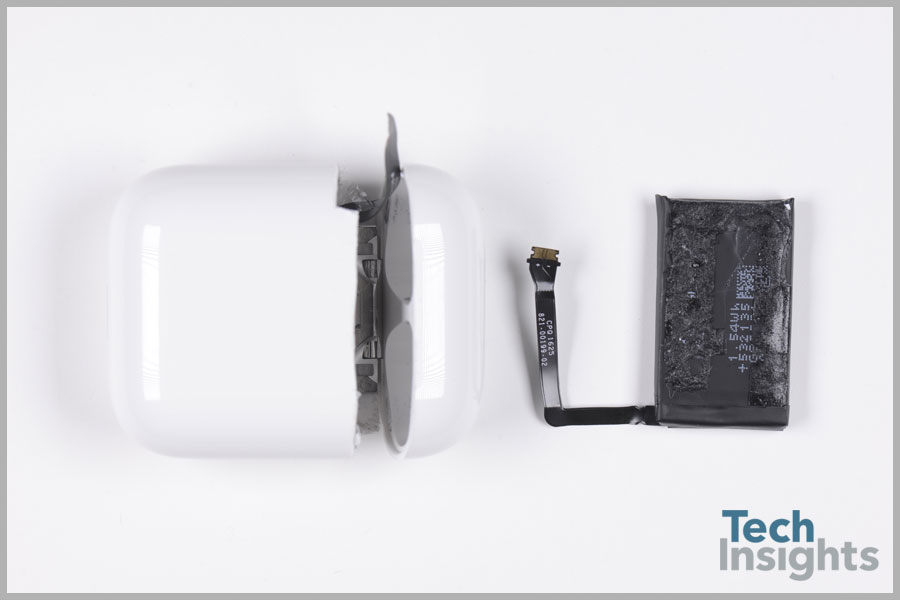
Apple AirPods Charger
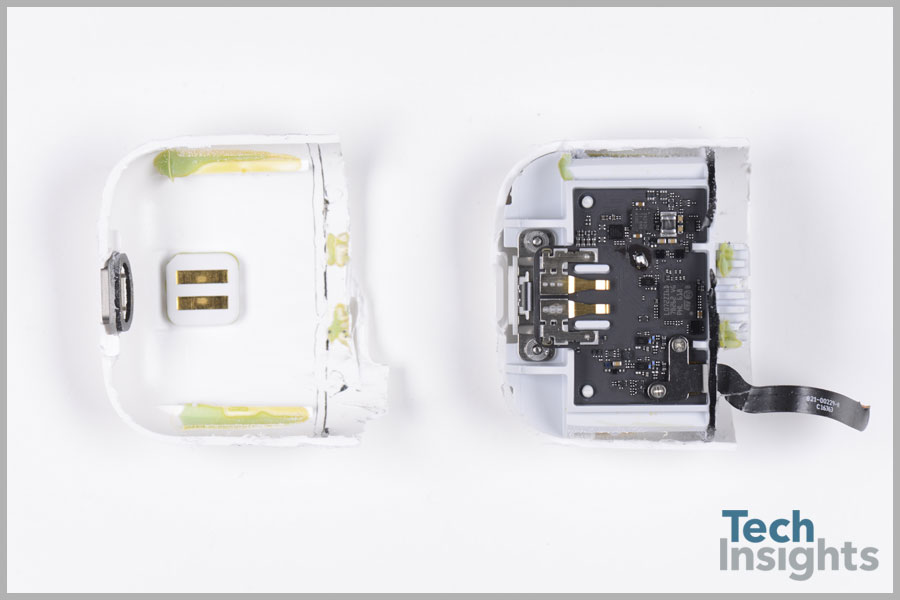
Apple AirPods Charger
Closer look at the charger
Next we take a look at the charger and the components inside it.
The main component counts of the charger are:
| Design | Component Count |
|---|---|
| 3.81 V, 1.52 Wh Lithium-ion cell rechargeable battery | 1 |
| STMicroelectronics ultra low power microcontroller | 1 |
| STMicroelectronics low dropout regulator | 1 |
| Fairchild charge control and protection device | 2 |
| Texas Instruments battery management IC | 1 |
| Texas Instruments DC-DC converter | 1 |
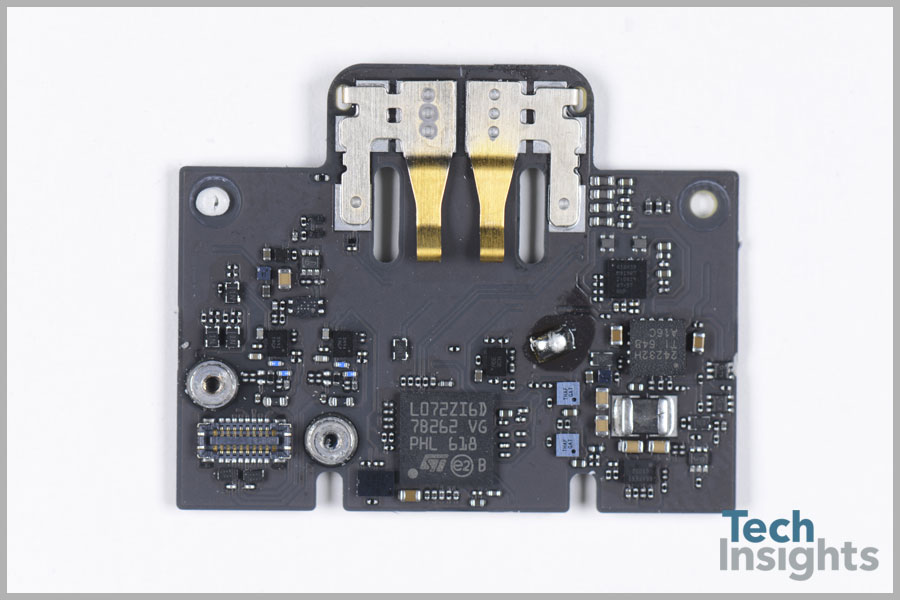
Package marks
Summary of all devices identified
The table is a summary of all the devices that we could identify based upon observations of the package marks or packaging characteristics. We count 28 devices in total for two ear buds and one charging station. At $219 USD per set of AirPods, we cannot wait to see what our colleagues in the DeepDive lab come up with for a cost estimate to manufacture this entire product. Stay tuned for more information!
| Manufacturer | Package Marks |
|---|---|
| Apple | 343S00130; P86847.10; B47101 SK; 1638 |
| Apple | 343S00130; PBBB18.00; B1800N SS; 1642 |
| Bosch | 8NJ; LA |
| Bosch | 8WM; LA |
| Cypress Semiconductor | CY8C4146FN; I-S443; 1625 A 04; PHI 624996 |
| Cypress Semiconductor | CY8C4146FN; I-S443; 1631 A 04; PHI 628131 |
| Fairchild | THAF; GAT |
| GoerTek Inc | 638; GWM1 |
| GoerTek Inc | 641; GWM1 |
| GoerTek Inc | 635; GWM1 |
| Maxim | +ADE; 9CN |
| Maxim | +MAX T; 98730EWJ; 9 634 QF E |
| Maxim | +MAX Tp; 98730EWJ; 9 640 RA E |
| NXP Semiconductors | 610A3B; MB1907; ZtD624; 07-57; (LOGO) |
| STMicroelectronics | L072ZI6D; 7B262 VG; PHL 618; (LOGO) (e2) B |
| STMicroelectronics | T; 6 30 |
| STMicroelectronics | T; 6 37 |
| Texas Instruments | 24232H; TI 548; A16C |
| Texas Instruments | 65AFKYI; TPS743 |
| Texas Instruments | 65AFKYI; TPS743 |
| Texas Instruments | 66AFE6I; 63050 |






